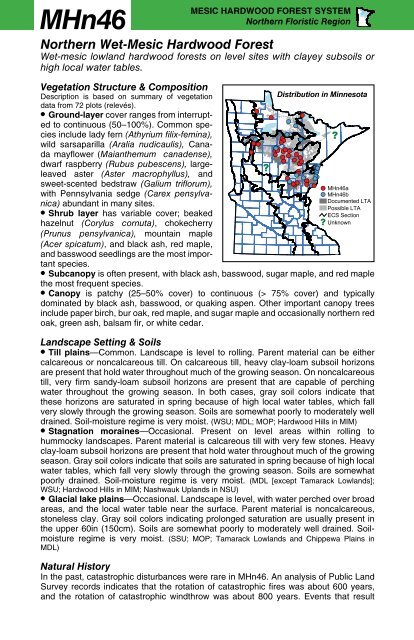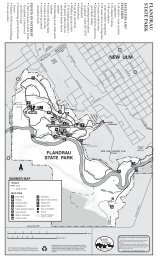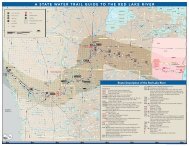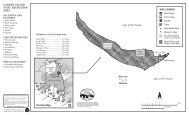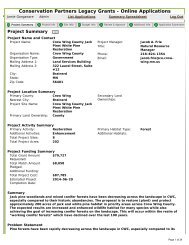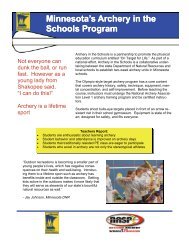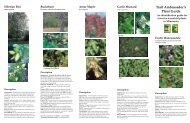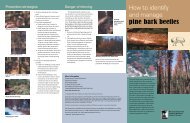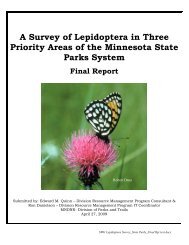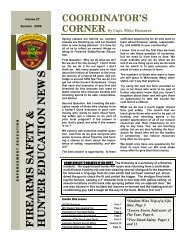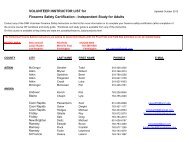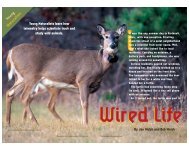MHn46 Northern Wet-Mesic Hardwood Forest factsheet
MHn46 Northern Wet-Mesic Hardwood Forest factsheet
MHn46 Northern Wet-Mesic Hardwood Forest factsheet
Create successful ePaper yourself
Turn your PDF publications into a flip-book with our unique Google optimized e-Paper software.
<strong>MHn46</strong><br />
MESIC HARDWOOD FOREST SYSTEM<br />
<strong>Northern</strong> Floristic Region<br />
<strong>Northern</strong> <strong>Wet</strong>-<strong>Mesic</strong> <strong>Hardwood</strong> <strong>Forest</strong><br />
<strong>Wet</strong>-mesic lowland hardwood forests on level sites with clayey subsoils or<br />
high local water tables.<br />
Vegetation Structure & Composition<br />
Description is based on summary of vegetation<br />
data from 72 plots (relevés).<br />
• Ground-layer cover ranges from interrupted<br />
to continuous (50–100%). Common species<br />
include lady fern (Athyrium filix-femina),<br />
wild sarsaparilla (Aralia nudicaulis), Canada<br />
mayflower (Maianthemum canadense),<br />
dwarf raspberry (Rubus pubescens), largeleaved<br />
aster (Aster macrophyllus), and<br />
sweet-scented bedstraw (Galium triflorum),<br />
with Pennsylvania sedge (Carex pensylvanica)<br />
abundant in many sites.<br />
• Shrub layer has variable cover; beaked<br />
hazelnut (Corylus cornuta), chokecherry<br />
(Prunus pensylvanica), mountain maple<br />
(Acer spicatum), and black ash, red maple,<br />
and basswood seedlings are the most important<br />
species.<br />
• Subcanopy is often present, with black ash, basswood, sugar maple, and red maple<br />
the most frequent species.<br />
• Canopy is patchy (25–50% cover) to continuous (> 75% cover) and typically<br />
dominated by black ash, basswood, or quaking aspen. Other important canopy trees<br />
include paper birch, bur oak, red maple, and sugar maple and occasionally northern red<br />
oak, green ash, balsam fir, or white cedar.<br />
Landscape Setting & Soils<br />
• Till plains—Common. Landscape is level to rolling. Parent material can be either<br />
calcareous or noncalcareous till. On calcareous till, heavy clay-loam subsoil horizons<br />
are present that hold water throughout much of the growing season. On noncalcareous<br />
till, very firm sandy-loam subsoil horizons are present that are capable of perching<br />
water throughout the growing season. In both cases, gray soil colors indicate that<br />
these horizons are saturated in spring because of high local water tables, which fall<br />
very slowly through the growing season. Soils are somewhat poorly to moderately well<br />
drained. Soil-moisture regime is very moist. (WSU; MDL; MOP; <strong>Hardwood</strong> Hills in MIM)<br />
• Stagnation moraines—Occasional. Present on level areas within rolling to<br />
hummocky landscapes. Parent material is calcareous till with very few stones. Heavy<br />
clay-loam subsoil horizons are present that hold water throughout much of the growing<br />
season. Gray soil colors indicate that soils are saturated in spring because of high local<br />
water tables, which fall very slowly through the growing season. Soils are somewhat<br />
poorly drained. Soil-moisture regime is very moist. (MDL [except Tamarack Lowlands];<br />
WSU; <strong>Hardwood</strong> Hills in MIM; Nashwauk Uplands in NSU)<br />
• Glacial lake plains—Occasional. Landscape is level, with water perched over broad<br />
areas, and the local water table near the surface. Parent material is noncalcareous,<br />
stoneless clay. Gray soil colors indicating prolonged saturation are usually present in<br />
the upper 60in (150cm). Soils are somewhat poorly to moderately well drained. Soilmoisture<br />
regime is very moist. (SSU; MOP; Tamarack Lowlands and Chippewa Plains in<br />
MDL)<br />
Natural History<br />
In the past, catastrophic disturbances were rare in <strong>MHn46</strong>. An analysis of Public Land<br />
Survey records indicates that the rotation of catastrophic fires was about 600 years,<br />
and the rotation of catastrophic windthrow was about 800 years. Events that result<br />
116
<strong>MHn46</strong><br />
- continued -<br />
in partial loss of trees, such as light surface fires and patchy windthrow, were much<br />
more common, with an estimated rotation of about 160 years. Based on the historic<br />
composition and age structure of these forests, <strong>MHn46</strong> had two growth stages separated<br />
by a long period of transition.<br />
• 0–35 years—Young forests recovering from fire or wind, strongly dominated by<br />
quaking aspen mixed with minor amounts of paper birch, black ash, basswood, and<br />
American elm.<br />
• 35–95 years—A transition period marked by a decline in quaking aspen and increases<br />
in paper birch, black ash, basswood, and American elm. White spruce and white pine<br />
become established in the understory. Bur oak, red maple, and balsam fir peak at this<br />
time, although they are not more than minor components.<br />
• > 95 years—Mature forests dominated by quaking aspen and white spruce. Paper<br />
birch, black ash, basswood, and American elm are also present. (White spruce is<br />
occasionally present in samples from modern forests but is not nearly as abundant as it apparently<br />
was in the past. American elm is present in just a few of the modern samples; it is certain to have<br />
been more common in the community in the past before the spread of Dutch elm disease through<br />
Minnesota.)<br />
Similar Native Plant Community Classes<br />
• MHn44 <strong>Northern</strong> <strong>Wet</strong>-<strong>Mesic</strong> Boreal <strong>Hardwood</strong>-Conifer <strong>Forest</strong><br />
MHn44 when dominated by hardwoods (MHn44a, MHn44c, or MHn44d) can be<br />
similar to <strong>MHn46</strong> when dominated by quaking aspen (<strong>MHn46</strong>a). MHn44 is more likely<br />
to have species indicative of poorer sites and with affinity for conifer-dominated WFn<br />
communities. <strong>MHn46</strong> is more likely to have species indicative of richer sites and with<br />
affinity for black ash–dominated WFn communities.<br />
<strong>MHn46</strong> Indicator Species<br />
(freq%)<br />
<strong>MHn46</strong> MHn44<br />
Common enchanter’s nightshade (Circaea lutetiana) 17 1<br />
Sensitive fern (Onoclea sensibilis) 34 4<br />
Ostrich fern (Matteuccia struthiopteris) 20 4<br />
Winterberry (Ilex verticillata) 27 5<br />
Erect, Smooth, or Illinois carrion-flower* 29 6<br />
Virginia creeper (Parthenocissus spp.) 37 8<br />
Nannyberry (Viburnum lentago) 34 11<br />
Jack-in-the-pulpit (Arisaema triphyllum) 54 19<br />
*Erect, Smooth, or Illinois carrion-flower (Smilax ecirrata, S. herbacea, or S. illinoensis)<br />
• WFn55 <strong>Northern</strong> <strong>Wet</strong> Ash Swamp<br />
WFn55 can be similar to and grade into occurrences of <strong>MHn46</strong> in low, level landscape<br />
settings. The canopy of WFn55 is usually strongly dominated by black ash, while black<br />
ash is likely to be mixed with other species such as basswood, bur oak, or quaking<br />
aspen in <strong>MHn46</strong>. WFn55 is more likely to have species characteristic of wet habitats<br />
such as vernal pools, while <strong>MHn46</strong> is more likely to have species with affinity for welldrained<br />
soils.<br />
<strong>MHn46</strong> Indicator Species<br />
(freq%)<br />
<strong>MHn46</strong> WFn55<br />
Round-lobed hepatica (Anemone americana) 39 2<br />
Pennsylvania sedge (Carex pensylvanica) 67 9<br />
Bracken (Pteridium aquilinum) 38 6<br />
Mountain rice grass (Oryzopsis asperifolia) 47 8<br />
Sugar maple (C) 25 4<br />
Bur oak (C) 35 8<br />
Ironwood (U) 36 9<br />
Downy arrowwood (Viburnum rafinesquianum) 40 10<br />
MESIC HARDWOOD FOREST SYSTEM<br />
<strong>Northern</strong> Floristic Region<br />
• MHc47 Central <strong>Wet</strong>-<strong>Mesic</strong> <strong>Hardwood</strong> <strong>Forest</strong><br />
MHc47 is very similar to <strong>MHn46</strong>, but its range is mainly south of <strong>MHn46</strong>. The ranges of<br />
the two classes overlap in the northern half of the WSU and the extreme southern part<br />
of the MDL. MHc47 is more likely to have species with affinity for central and southern<br />
forests, while <strong>MHn46</strong> is more likely to have species with affinity for northern forests.<br />
117<br />
MHn44 Indicator Species<br />
(freq%)<br />
<strong>MHn46</strong> MHn44<br />
False melic grass (Schizachne purpurascens) - 15<br />
Kidney-leaved violet (Viola renifolia) - 12<br />
Twinflower (Linnaea borealis) - 11<br />
Balsam fir (C) 5 42<br />
Lowbush blueberry (Vaccinium angustifolium) 2 16<br />
White spruce (C,U) 7 26<br />
Balsam poplar (U) 7 22<br />
Veiny pea (Lathyrus venosus) 7 21<br />
WFn55 Indicator Species<br />
(freq%)<br />
<strong>MHn46</strong> WFn55<br />
Rough bedstraw (Galium asprellum) 1 28<br />
Red-stemmed aster (Aster puniceus) 3 34<br />
Fowl manna grass (Glyceria striata) 6 51<br />
Mad dog skullcap (Scutellaria lateriflora) 4 32<br />
Swamp thistle (Cirsium muticum) 4 27<br />
<strong>Northern</strong> bugleweed (Lycopus uniflorus) 7 37<br />
Wild black currant (Ribes americanum) 6 29<br />
Common marsh marigold (Caltha palustris) 10 37
<strong>MHn46</strong><br />
- continued -<br />
<strong>MHn46</strong> Indicator Species<br />
(freq%)<br />
<strong>MHn46</strong> MHc47<br />
Common oak fern (Gymnocarpium dryopteris) 28 -<br />
Bunchberry (Cornus canadensis) 24 -<br />
Mountain maple (Acer spicatum) 67 4<br />
Palmate sweet coltsfoot (Petasites frigidus) 26 4<br />
Balsam fir (C,U) 38 9<br />
Woodland horsetail (Equisetum sylvaticum) 35 9<br />
Starflower (Trientalis borealis) 49 13<br />
Swamp red currant (Ribes triste) 42 13<br />
MESIC HARDWOOD FOREST SYSTEM<br />
<strong>Northern</strong> Floristic Region<br />
Native Plant Community Types in Class<br />
• <strong>MHn46</strong>a Aspen - Ash <strong>Forest</strong><br />
Canopy is dominated most commonly by basswood, bur oak, quaking aspen, black ash,<br />
or red maple, with smaller amounts of paper birch. Other species such as northern red<br />
oak, green ash, and sugar maple occasionally are abundant in the canopy. Basswood,<br />
black ash, red maple, American elm, and bur oak are the most common species in<br />
the subcanopy. <strong>MHn46</strong>a differs from <strong>MHn46</strong>b by having greater frequency of quaking<br />
aspen in the canopy and understory, and greater frequency of juneberries (Amelanchier<br />
spp.), highbush cranberry (Viburnum trilobum), winterberry (Ilex verticillata), downy<br />
arrowwood (Viburnum rafinesquianum), prickly or smooth wild rose (Rosa acicularis<br />
or R. blanda), and other shrubs uncommon in densely shaded forests. Poison ivy<br />
(Toxicodendron rydbergii) and bracken (Pteridium aquilinum), are also more common<br />
in <strong>MHn46</strong>a. <strong>MHn46</strong>a has been documented primarily in the WSU and MDL but also<br />
occurs in the MOP, SSU, the western edge of NSU, and in northern MIM. Description is<br />
based on summary of vegetation data from 41 plots.<br />
• <strong>MHn46</strong>b Black Ash - Basswood <strong>Forest</strong><br />
Rich forests, typically dominated by black ash, usually with basswood and occasionally<br />
with sugar maple, white cedar, or green ash. Other occasional canopy species include<br />
paper birch, red maple, balsam fir, yellow birch, quaking aspen, and white spruce. Black<br />
ash and sugar maple are important in the subcanopy. <strong>MHn46</strong>b differs from <strong>MHn46</strong>a<br />
by having a denser tree canopy, greater abundance of late-successional tree species<br />
such as black ash, sugar maple, and white cedar, and lower abundance of earlysuccessional<br />
species such as quaking aspen. Other species that help to distinguish<br />
<strong>MHn46</strong>b from <strong>MHn46</strong>a include common oak fern (Gymnocarpium dryopteris), alpine<br />
enchanter’s nightshade (Circaea alpina), dandelions (Taraxacum spp.), hooked<br />
crowfoot (Ranunculus recurvatus), blue cohosh (Caulophyllum thalictroides), wood<br />
nettle (Laportea canadensis), long beech fern (Phegopteris connectilis), white avens<br />
(Geum canadense), and wild leek (Allium tricoccum). <strong>MHn46</strong>b is common in the SSU<br />
and WSU, extending north to the northern part of the <strong>Hardwood</strong> Hills Subsection in the<br />
MIM, the Chippewa Plains Subsection in the MDL, the Little Fork Vermilion Uplands<br />
Subsection in the MOP, and the extreme western edge of the NSU. Description is based<br />
on summary of vegetation data from 31 plots.<br />
118<br />
MHc47 Indicator Species<br />
(freq%)<br />
<strong>MHn46</strong> MHc47<br />
Wild geranium (Geranium maculatum) 3 61<br />
Honewort (Cryptotaenia canadensis) 3 52<br />
Pointed-leaved tick trefoil (Desmodium glutinosum) 4 70<br />
Prickly ash (Zanthoxylum americanum) 3 43<br />
Lopseed (Phryma leptostachya) 4 52<br />
Maidenhair fern (Adiantum pedatum) 3 35<br />
Hawthorn (Crataegus spp.) 8 57<br />
Blue beech (U) 13 70
<strong>MHn46</strong><br />
- continued -<br />
MESIC HARDWOOD FOREST SYSTEM<br />
<strong>Northern</strong> Floristic Region<br />
<strong>MHn46</strong> <strong>Northern</strong> <strong>Wet</strong>-<strong>Mesic</strong> <strong>Hardwood</strong> <strong>Forest</strong> – Species Frequency & Cover<br />
freq% cover<br />
freq% cover<br />
Forbs, Ferns & Fern Allies<br />
Bearded shorthusk (Brachyelytrum erectum) 50 •<br />
Wild sarsaparilla (Aralia nudicaulis) 86 •• Graceful sedge (Carex gracillima) 49 •<br />
Lady fern (Athyrium filix-femina) 85 ••• Mountain rice grass (Oryzopsis asperifolia) 47 ••<br />
Canada mayflower (Maianthemum canadense) 83 • Dewey’s sedge (Carex deweyana) 36 •<br />
Dwarf raspberry (Rubus pubescens) 83 •• Bladder sedge (Carex intumescens) 36 •<br />
Large-leaved aster (Aster macrophyllus) 81 •• Pointed woodrush (Luzula acuminata) 36 •<br />
Sweet-scented bedstraw (Galium triflorum) 79 • Shrubs<br />
Wild ginger (Asarum canadense) 71 • Beaked hazelnut (Corylus cornuta) 92 •••<br />
Common strawberry (Fragaria virginiana) 69 • Chokecherry (Prunus virginiana) 71 •<br />
Clayton’s sweet cicely (Osmorhiza claytonii) 65 • Mountain maple (Acer spicatum) 67 •••<br />
Wood anemone (Anemone quinquefolia) 65 • Juneberries (Amelanchier spp.) 44 •<br />
Rose twistedstalk (Streptopus roseus) 64 • Swamp red currant (Ribes triste) 42 •<br />
Jack-in-the-pulpit (Arisaema triphyllum) 64 • Pagoda dogwood (Cornus alternifolia) 36 •<br />
Maryland black snakeroot (Sanicula marilandica) 64 • Highbush cranberry (Viburnum trilobum) 25 •<br />
Red baneberry (Actaea rubra) 63 • Nannyberry (Viburnum lentago) 25 •<br />
Early meadow-rue (Thalictrum dioicum) 57 • American hazelnut (Corylus americana) 24 •••<br />
Rugulose or Yellow violet (Viola canadensis or V. pubescens) 54 •<br />
Rattlesnake fern (Botrychium virginianum) 53 • Trees Canopy Subcanopy Shrub Layer<br />
Large-flowered bellwort (Uvularia grandiflora) 50 •<br />
freq% cover freq% cover freq% cover<br />
Bluebead lily (Clintonia borealis) 49 • Black ash 65 •••• 58 ••• 71 ••<br />
Starflower (Trientalis borealis) 49 • Basswood 60 •• 56 •• 63 •<br />
Spinulose shield fern or Glandular wood fern* 49 • Quaking aspen 38 ••• 17 ••• 38 •<br />
Nodding trillium (Trillium cernuum) 43 • Paper birch 36 •• 21 •• 11 •<br />
Naked miterwort (Mitella nuda) 42 • Bur oak 35 ••• 26 • 43 •<br />
Side-flowering aster (Aster lateriflorus) 38 • Red maple 32 ••• 40 ••• 60 •<br />
Woodland horsetail (Equisetum sylvaticum) 35 •• Sugar maple 25 ••• 46 ••• 53 •••<br />
Ostrich fern (Matteuccia struthiopteris) 33 ••• <strong>Northern</strong> red oak 15 ••• 15 • 46 •<br />
Touch-me-not (Impatiens spp.) 29 • Yellow birch 14 •• 8 • - -<br />
Sensitive fern (Onoclea sensibilis) 28 • American elm 14 • 40 •• 44 •<br />
Palmate sweet coltsfoot (Petasites frigidus) 26 • Green ash 14 ••• 22 •• 31 ••<br />
Hooked crowfoot (Ranunculus recurvatus) 24 • White spruce 11 •• 13 • 14 •<br />
Wood nettle (Laportea canadensis) 17 ••• Balsam fir 11 ••• 17 • 35 •<br />
Grasses & Sedges<br />
White cedar 8 ••• - - - -<br />
Pennsylvania sedge (Carex pensylvanica) 67 ••• Big-toothed aspen - - 8 •• - -<br />
Long-stalked sedge (Carex pedunculata) 56 •• Balsam poplar - - - - 8 •<br />
* Spinulose shield fern or Glandular wood fern (Dryopteris carthusiana or D. intermedia)<br />
119


